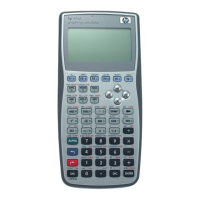1-20 RPL Programming
Syntax Flowchart
Start
finish
FOR
loop-clause
NEXT
1:Start
2:finish
counter=start
Store finish
Body of loop
counter = counter + 1
Is
counter ≤ finish?
yes
no
FOR … NEXT Structure
FOR takes start and finish from the stack as the beginning and ending values for the loop counter, then creates
the local variable counter as a loop counter. Then the loop-clause is executed — counter can appear within the
loop-clause. NEXT increments counter by one, and then tests whether its value is less than or equal to finish. If
so, the loop-clause is repeated (with the new value of counter) — otherwise, execution resumes following
NEXT. When the loop is exited, counter is purged.
To enter FOR … NEXT in a program:
! Press !°%BRCH% ! %FOR%.
Example: The following program places the squares of the integers 1 through 5 on the stack:
« 1 5 FOR j j SQ NEXT »
Example: The following program takes the value x from the stack and computes the integer powers i of x. For
example, when x =12 and start and finish are 3 and 5 respectively, the program returns 12
3
, 12
4
and 12
5
. It
requires as inputs start and finish in level 3 and 2, and x in level 1. ( x removes x from the stack, leaving start
and finish there as arguments for FOR.)
"!!x!"!7LK!G!!+?WG+!<NBE!=<T:!1!1!
The FOR … STEP Structure
The syntax for this structure is
! «!…!start finish!FOR!counter loop-clause increment STEP!…!»
FOR … STEP executes the loop-clause sequence just like FOR … NEXT does — except that the program
specifies the increment value for counter, rather than incrementing by 1. The loop-clause is always executed at
least once.

